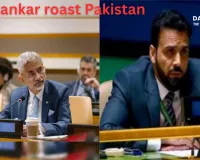India Rises as Global Talent Hub Amid US, EU Visa Restrictions
Digital Desk

As major economies such as the US and the EU tighten visa norms and restrict new migration routes, India is rapidly rising as a global hub for skilled talent. With growing global demand for professionals in technology, engineering, healthcare, and manufacturing, nations across Russia and the Gulf are increasingly turning to India’s vast, highly trained workforce.
This shift is not only helping ease global skill shortages but also positioning India as a key driver of the international economy, reshaping the dynamics of global labour mobility.
Indian Americans Face Fresh Challenges
The Indian diaspora in the US, numbering over 5.2 million, remains one of the most prosperous immigrant communities—half of Indian-American households earn more than US$160,000 annually. They continue to play leading roles in technology, academia, and corporate America.
However, new obstacles are emerging. Starting September 21, 2025, the US imposed a one-time fee of US$100,000 on new H-1B visa petitions, significantly impacting Indian tech professionals. In addition, the US has raised tariffs on Indian imports to 50%, leading to a 22% drop in India’s exports between May and August 2025.
Despite these challenges, Indian professionals remain at the core of Silicon Valley’s innovation ecosystem and hold top positions in Fortune 500 companies, reaffirming their lasting contribution to the American economy.
Indians in the UK: Trade Push, Visa Freeze
During his recent visit to India, UK Prime Minister Sir Keir Starmer highlighted “massive opportunities” to expand trade and cultural cooperation between the two nations. However, he made it clear that no new visa routes for Indian workers or students are being considered.
The UK’s Indian-origin community, over 1.8 million strong, is the country’s largest ethnic minority, with roots primarily in Punjab, Gujarat, and Bengal. They have excelled across healthcare, technology, engineering, and politics.
The recently signed UK-India Free Trade Agreement includes a Double Contributions Convention, which exempts around 75,000 Indian professionals from paying UK social security contributions for up to 36 months, offering significant relief to Indian firms and workers.
Russia’s Labour Shortage Opens Doors for Indian Workers
Facing a labour deficit of 3.1 million workers by 2030, Russia is expanding foreign recruitment. In 2025, Moscow announced a 1.5-fold increase in foreign worker quotas, allowing around 234,900 foreign hires, including 71,817 work permits for Indians.
While Indian workers have traditionally been employed in construction and textiles, demand is now growing for engineers, technicians, and specialists in machinery, electronics, and defence manufacturing.
India’s Ambassador to Moscow, Vinay Kumar, confirmed that Russian companies are “actively hiring Indians under regulated quotas.” Demographic factors are central to this trend—Russia’s fertility rate has fallen to 1.41 children per woman, and its population has declined from 147.2 million in 2021 to 146 million in 2025. Currently, about 62,800 Indians reside in Russia, many working in critical industrial sectors.
Indians in West Asia
More than 9 million Indians live and work in West Asia, primarily in the UAE (3.5 million) and Saudi Arabia (2.5 million). They are engaged in both skilled and unskilled professions—from nurses, engineers, and technicians to construction and service workers.
Beyond economic impact, the Indian diaspora has strengthened India’s cultural presence in the region, reflected in the popularity of Bollywood and landmarks like the BAPS Hindu Temple in Abu Dhabi.
From Colonial Labour to Global Workforce
India’s global workforce journey began during colonial times, when millions of Indians were sent abroad as indentured labourers after slavery was abolished in 1833. Between 1834 and 1917, over 1.6 million Indians were transported to colonies such as Mauritius, Fiji, Trinidad and Tobago, Guyana, South Africa, and the Caribbean to work on plantations under harsh and exploitative conditions.
Gandhi’s Fight Against the Indenture System
In 1913, Mahatma Gandhi led a movement in South Africa protesting a discriminatory tax on former indentured workers. His activism drew global attention to their exploitation and contributed to the abolition of the indenture system in 1917.
India’s Strategic Edge in the Global Labour Market
With a young population, a rapidly expanding education system, and a strong focus on skill development, India has become the most reliable source of skilled professionals for the world. From Russia’s factories and Gulf hospitals to America’s tech hubs and Japan’s ageing workforce, Indian talent is indispensable.
This global workforce not only brings economic gains but also strengthens India’s diplomatic relations, expands cultural influence, and enhances soft power—each migration wave adding a new chapter to India’s international engagement.
Seizing the Global Opportunity
As the world faces a shrinking working-age population and rising industrial demand, India is poised to play a central role in shaping the future of global labour markets.
Experts emphasize that sustained investment in education, vocational training, and safe migration frameworks will be essential. By empowering its workforce and building robust bilateral partnerships, India can bridge the global skill gap and secure its position as the world’s most sought-after talent hub—a win-win for India and the global economy.

20.png)



.jpg)
.jpg)
.jpg)
.jpg)
.jpg)
.jpg)
